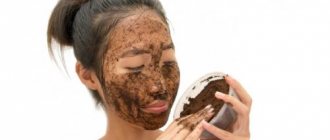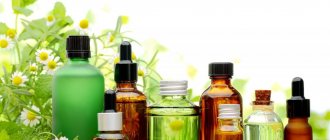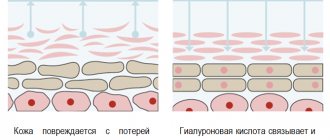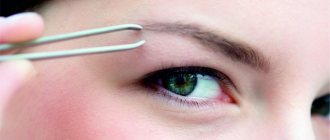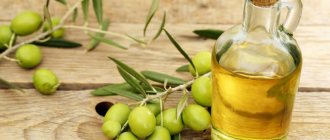One of the main steps to getting radiant and youthful facial skin is to get rid of dry, dead cells.
Exfoliation is considered a very important part of any skin care routine. Not only does it eliminate dead cells, but it also removes sebum and impurities that can lead to enlarged pores. Most store-bought beauty scrubs contain unknown, questionable ingredients that can cause various allergic reactions. Therefore, a DIY exfoliating mask using natural ingredients will have the best effect on your facial skin.
The facial peeling mask can be used two to three times a week, but not every day. Along with this, it is necessary to check each new skin care product for the occurrence of an allergic reaction.
Nourishing sugar mask with exfoliating effect
Sugar granules are a wonderful natural cosmetic product that helps quickly exfoliate the upper layer of the epidermis.
To make a sugar exfoliating face mask, combine 1 teaspoon of brown sugar with ½ teaspoon of honey, a little lemon juice and mix well. If the mixture is runny, you can add additional sugar.
Baking Soda Exfoliating Mask
Baking soda is very fine in size and that is why it acts as a gentle exfoliant. Using a soda face mask, you can not only gently cleanse your skin, but also get rid of acne.
In order to prepare it, you need to mix ½ spoon of baking soda with a small amount of grape seed essential oil or a mild cleanser. Or just mix baking soda with water. The finished mixture must be very carefully rubbed into the skin of the face and left for 5 - 10 minutes. Afterwards rinse with water.
Why do you need to exfoliate?
Exfoliation or exfoliation refers to the process of removing dead cells from the surface of the skin. If they accumulate excessively, sensitivity to skincare products worsens; small scales close pores and increase the risk of acne formation. By supporting the natural process of epithelium renewal, it is possible to keep the skin beautiful and healthy.
Exfoliation is recommended for people with all skin types, but special attention should be paid to oily, combination and problem skin. By exfoliating, it is possible to stimulate the growth of new cells, which has a rejuvenating effect in adulthood. And reducing the number of melanocytes helps fight unwanted pigmentation.
Invigorating peeling face mask with coffee
Another fantastic natural exfoliator is coffee. It is rich in caffeic acid, which acts as an antiseptic on the skin and also increases collagen production. For the scrub, you will need to mix ½ tablespoon of ground coffee with 1 tablespoon of water or flaxseed oil. Apply to skin with light massaging movements for 30 seconds and leave for another 15 minutes. Then rinse gently with rose water.
Soothing Exfoliating Oatmeal Mask
Oatmeal as a natural facial scrub is great at removing and absorbing impurities, leaving skin nourished and hydrated. Due to its character, the oatmeal scrub is very soft and is perfectly suitable for people with very sensitive skin. To prepare it, you need to combine 1 tablespoon of ground oatmeal with ¼ teaspoon of salt and 1 teaspoon of warm boiled water or sunflower oil. Mix until a smooth paste forms. Apply onto the skin using gentle circular movements and leave for 5-15 minutes, then rinse off with a cosmetic sponge.
Honey exfoliating mask
Honey is antibacterial, antiviral and antifungal. It kills skin infections, eliminates acne, reduces inflammation and moisturizes. For an exfoliating mask, it is best to use honey in combination with baking soda or oatmeal. The components must be mixed in equal parts and distributed with soft circular movements throughout the face. Leave for 35 minutes and then rinse off with a soft sponge.
Mix a spoonful of liquid honey with ½ spoonful of cinnamon and nutmeg until smooth. Then spread the mask over your face with light massaging movements, avoiding the area around the eyes and wait about 15 minutes. After the time has passed, wash your face with warm (but not hot) running water.
Contraindications
Exfoliating products prepared both at home and purchased options have some contraindications:
- allergic reaction to certain components;
- problematic skin type (pimples, blackheads, rashes, skin pathologies).
When choosing recipes for a specific skin type, have a rational idea of its general condition. For example, if you have a fatty type, it is strictly forbidden to use “fatty” ingredients, such as cream and sour cream. For dry skin - ingredients that have a drying effect - baking soda, peroxide.
Without obvious contraindications, you should not refuse such care, because exfoliating masks have a strong cleansing effect, rejuvenate, restore, improve appearance and general condition.
Gelatin peeling mask for face cleansing
This mask perfectly cleanses the top layer of skin from impurities, eliminates dry cells and helps heal acne. To prepare it, you will need to combine a teaspoon of gelatin and 1 tablespoon of milk in a bowl. Mix well and place in a water bath until smooth. Then cool a little and spread on the face, paying special attention to the T-zone and chin. After 10 - 15 minutes, the mask will dry and you can carefully remove it. Wash off any remaining residue with a damp towel.
Facial skin exfoliation technology
- If you have medium-length hair, fix the head in such a way that the curls do not interfere with the procedure. If necessary, use a headband if you have bangs.
- Prepare to steam your facial skin. Wet the cloth with hot water. Consider the temperature; this move will allow you to avoid burns. Take a lying position, place a towel on your face, wait 10 minutes. In the allotted time, the skin will steam and the pores will open.
- A five-minute hot shower is also suitable for this procedure. Afterwards, rinse your face with foam cleanser. Don't put in a lot of effort, you just need to prepare the dermis for exfoliation. Next, apply the targeted scrub to clean, prepared skin.
- Wet 2 fingers in warm water and distribute the composition with massage movements, you can use a soft sponge. After completing the procedure, you will get rid of dead skin cells. If you use a washcloth, alternate rubbing with stroking.
- Please keep in mind that the skin should not be damaged during the procedure. After this, rinse the scrub with non-hot water, then repeat the manipulations with cool liquid. Such actions will help narrow pores and even out the skin. Remove excess moisture with a clean terry towel, do not rub it.
- Apply a nourishing composition with SPF filters to your face. The cream will help smooth the dermis and help protect against ulcers and UV rays. Be careful, exfoliated skin is vulnerable to the sun. Repeat the scrubbing procedure correctly.
- If you have oily, elastic skin, exfoliation can be done daily. Otherwise, manipulations should be done twice a week. Gradually reduce the amount of exfoliation to a minimum, and if necessary, seek help from a cosmetologist.
how to care for problem skin
Lemon Exfoliating & Hydrating Mask
Lemon contains acid that will help remove the top layer of the epidermis and thoroughly cleanse the skin.
Mix some unsweetened yogurt with lemon juice and apply a thick layer to your face. This mask can be kept for 5 to 15 minutes.
Mix a tablespoon of crystallized honey, 2 tablespoons of fine salt and a spoonful of lemon juice. Rub the resulting mixture with light circular movements into the skin for 2 minutes, then leave for 5 - 7 minutes and rinse with warm water. Dry your face with a clean towel and apply nourishing cream.
Exfoliating clay mask
Clay is an excellent skin cleanser of various impurities, which is why it is often used for deep peeling. To create a mask, you need to steam a tablespoon of clay with boiling water, then cool and mix in cucumber puree with a few drops of olive oil. Using light massaging movements, spread a thin layer on the face and leave for about 20 minutes. Rinse off with a sponge.
Beauty recipes and folk remedies
Traditional medicine will help you get rid of peeling skin on your face and prevent this process in advance. Before you start applying the mask to your face, your skin should be prepared. First you need to wash off all cosmetics, including creams.
Then you need to steam your face so that the pores on the skin open as much as possible to absorb the components that the mask offers. To do this, you need to hold your face in hot steam for 5-10 minutes. But you should be careful not to burn yourself; the temperature from the steam of boiling water is the same as in the boiling water itself.
Don't miss the most popular article in the section: Face fitness for facelift, rejuvenation, muscle tone. Master class from Elena Karkukli
Carrot mask
Thanks to the carotene and retinol contained in carrots, the fresh vegetable helps cope with dry face. In addition to these properties, carrots contain vitamins that fight swelling and inflammation, reducing the number of swollen capillaries that form spider veins on the face.
To prepare a carrot mask, you should:
- Grate fresh carrots as finely as possible, you can use a blender.
- Mix it with cosmetic or natural oil for dry skin and with egg white for oily skin.
- The mask should be kept on the face for no more than 15 minutes to avoid turning the skin orange.
Oatmeal mask
An old recipe made from oatmeal will help you get rid of flaking skin on your face and even out its tone. Oatmeal, in addition to its whitening properties, serves as an active ingredient for making scrubs at home. Since the flakes are quite dry and remove excess moisture from the skin, they should be mixed with other moisturizing ingredients.
Fatty dairy products are suitable for this, for example:
- high percentage sour cream;
- kefir;
- cottage cheese.
The main thing is that the other ingredients contain enough fat and have viscous properties to hold the ground oatmeal on the face.
For example:
- Before making the mask, oatmeal should be ground in a coffee grinder to a powder.
- Then, in a separate bowl, mix with the second ingredient.
- You can keep the mask on your face for a long time without fear of getting an unwanted reaction; you should start with 30 minutes. for 1 time.
If the second ingredient is lemon or clay (for oily skin), the mask should be washed off after 15 minutes.
Glycerin based mask
Many different cosmetics, hand creams, soaps, and even dishwashing detergents are made from glycerin. And all because glycerin has a cleansing effect, moisturizing the epidermis, and for flaky skin, this is the main property.
However, when preparing a mask, glycerin must be diluted 1:10 and not used in a room with a humidity of more than 45% - this will create the opposite effect, evaporating the liquid from the skin.
A glycerin-based face mask for dry skin can be prepared with the addition of olive oil or vegetable oil; liquid honey is also suitable. For 100 g of oil add 10 g of glycerin. The mask is applied for 15-20 minutes. then washed off with warm water.
Curd mask
Cottage cheese, like carrots, contains carotene and retinol (vitamins A and PP), which help moisturize the skin. The dairy product contains collagen, on the basis of which anti-aging masks and injections are made.
Therefore, a curd mask not only helps prevent skin flaking, but also provides a rejuvenating effect. Cottage cheese does not need to be mixed with other ingredients. The only thing worth considering is the fat percentage.
Average:
- for normal skin 3-9%;
- for oily skin, you should choose a product less than 3%;
- for dry – more than 9%.
Apply the mask once a week.
Apple-honey mask
The combination of apple and honey is, first of all, a combination of vitamin C, iron and a bactericidal base. The vitamins contained in apples saturate the skin with oxygen, optimizing metabolism, and honey, having wound-healing properties, promotes rapid restoration of the skin from microcracks. Honey, however, should be floral.
To prepare the mask, grate half an apple and mix the apple porridge with honey until it becomes viscous and sticks to the skin. Leave the mask for 20-25 minutes. then wash your face with warm water.
Olive-oat mask
Cleansing your face with oatmeal is an effective homemade scrub that polishes the skin from rough scales and helps evaporate excess moisture and oil. In other words, oats in their pure form should not be applied to dry skin; they should be mixed with another, oilier ingredient.
Unlike regular vegetable oil, olive oil contains monounsaturated fats, which have a beneficial effect on the epidermis without irritating it.
To do this you need:
- To prepare the mask, you should grind the oatmeal until it becomes flour or at least semolina. To do this, you can use a rolling pin or coffee grinder.
- Then mix the resulting powder with olive oil to the consistency of thick sour cream.
- The composition should be left on the face for 20 minutes, after which wash the face with warm water.
Cleansing the skin with bread and milk
Millet, from which flour is ground and then bread is baked, has a wide range of vitamins B, E and various amino acids, the main function of which is to improve skin health. In order for a face mask made from bread crumbs to be effective for problems with flaking skin, you should give preference to white bread.
Black and rye bread are used for oily skin.
To prepare bread for the mask, it should be broken into pieces and softened in unpasteurized milk. If the consistency is not stable enough for maxi, you can add premium flour. Apply the mask to previously prepared cleansed skin for 15-20 minutes.
Facial cleansing with milk and oil
Fresh village milk, which is most suitable for nourishing the skin, contains protein, calcium and other vitamins that restore keratinized, flaky skin. A combination of milk with vegetable or olive oil is used for dry skin to activate the sebaceous glands.
A milk mask is how you can get rid of flaking skin.
Milk for the mask should be of medium or low fat content, up to 3%; the rest of the fat content of the mask is provided by butter. Then milk is mixed with oil 1:2 and applied in a thin layer to the skin of the face. Leave for 20 minutes, then wash your face with warm water.
Mint compress
Mint leaves, which are collected in June-July, contain carotene - the most important ingredient for skin rejuvenation, optimizing cellular metabolism, vitamin C - which relieves inflammation of the walls of blood vessels, vitamin B9 - which stimulates cell regeneration and other substances that have whitening and wound-healing properties.
A mint compress is used to cleanse the skin. It is prepared simply - mint leaves are crushed with a masher in a bowl, and the resulting pulp is applied to the face. Mint can be mixed with honey, eggs, chamomile, etc.
Mint lemon cream
Vitamin C contained in lemon primarily helps to optimize blood circulation and strengthen the walls of blood vessels. In addition, lemon juice brightens the skin, which is especially important for people with increased pigmentation. If you make a face cream from lemon and mint, you will get a recipe that stimulates the production of collagen, which restores dead skin.
To prepare the cream you will need 3 ingredients:
- mint leaves;
- lemon;
- baby cream
Fresh mint leaves are pounded with a masher, lemon slices are also crushed into porridge, after removing the grains and peel. The resulting mixture is mixed with baby cream. The recipe is ready and should be stored in the refrigerator.
Linden decoction for peeling
Linden flowers, from which bees extract honey, have a whole range of substances beneficial for the skin. However, when it comes to helping dry, flaky skin, the secret of linden lies in the polysaccharides that can retain moisture in the skin's pores.
Daily washing with linden decoction replaces artificial tonics for cleansing the face thanks to the same polysaccharides that activate macrophages that protect the skin from external influences.
Linden decoction is prepared in boiling water. For this, 1 tbsp. l. linden flowers are steamed in 0.5 liters of boiling water and left to infuse for an hour. Next, the decoction, filtered through a strainer, is applied to the skin using cotton wool.
Flax seed mask
Alphalinoleic acid is the same component in flax seeds that helps moisturize the skin. In addition to this effect, flaxseeds cope with inflammatory processes on the skin (pimples, blackheads) and, thanks to vitamin K1, whiten the skin.
A mask made from flaxseeds, or more precisely from the mucus they secrete, is made in its pure form, that is, only from the seeds, and with the addition of various components.
To extract mucus from seeds, you need to pour 1 tsp. 1/3 cup boiling water and leave to steep for 5 hours. The resulting mucus should be rubbed onto your face in several layers. Once the mask dries, wash your face with warm water.
Pumpkin mask
The moisturizing effect of a pumpkin mask is achieved due to the starch contained in the vegetable, which smoothes dead skin. In addition to this component, pumpkin contains vitamin B2, which reduces inflammation, and B1, which creates a protective layer against ultraviolet radiation.
To prepare a pumpkin mask, you should take a fresh vegetable, about 200 g, grate it until pureed, and mix it with olive or vegetable oil until creamy. The mixture is applied in a thin layer to the face using a sponge and left for 20 minutes.
St. John's wort oil
The main effect that St. John's wort oil has on the body is to soothe the skin, mucous membranes and have a bactericidal effect. When applying oil to flaky facial skin, not only a moisturizing effect is achieved, as with any oil, but a wound healing effect.
If your skin has small cracks or inflamed acne, rubbing your face with St. John's wort oil will speed up the healing process.
The oil of a flower is collected from its stem at the moment of flowering. By pressing the collected fresh stems, you obtain oil that is ready for local use in its fresh form. Apply a thin layer of oil to the face and allow it to be completely absorbed. It is not necessary to wash your face after this if there is no excess substance.
Grape mask
Grapes, as a seasonal berry, can replace lemons and apples as a face mask. It, like other sour berries and fruits, contains vitamin C, which helps strengthen blood vessels, and therefore speeds up metabolism, vitamin A, which promotes cell regeneration, and potassium, which is a moisturizing component for flaky skin.
To create a grape mask, you should take a sprig of fresh berries, grind them to a porridge, mix with egg yolk and leave on your face for 20 minutes. You can add honey or almond oil to the mask, this will make the mask more nutritious.
Exfoliating orange peel mask
Orange peels have a very positive effect on the skin. They are rich in antioxidants and free radicals, which help in maintaining healthy and youthful skin. Orange peel masks are used to control acne, unclog clogged pores, treat blackheads, eliminate shine and brighten skin. To create an orange peel peel mask, you will need to mix finely ground orange peel, a teaspoon of honey and yogurt. Apply the mixture only to a washed face and neck using gentle circular movements. Leave for 15 - 25 minutes, then rinse with water. It is recommended to use 2 times a week.
Create DIY exfoliating face masks with natural ingredients and enjoy beautiful results!
How to remove dead cells?
Removing exfoliated skin from your face is an important step in skin care. Without periodic exfoliation, it is difficult to maintain the normal state of the epithelium, so all cosmetologists recommend regularly carrying out this procedure in the salon or at home. But even if you do it yourself, it’s still better to ask a specialist how to exfoliate your skin correctly.
General rules of procedure
In order not to harm the skin, but to get only a positive result, you first need to understand what type of epithelium you are dealing with, because they react differently to exfoliation:
- For those who are sensitive, gentle manipulations are required, which are recommended to be completed by applying an alginate mask.
- After exfoliation, dry skin is lubricated with a moisturizing and healing cream (cleaning is carried out once a month).
- Oily, combination and problematic skin types require more frequent procedures (up to 2-3 times a week).
Regardless of your skin type, you should start the procedure with makeup removal and washing with cleansing foam or gel. Exfoliating products are applied to a wet (scrub) or dry (mask) face. After the required time has passed, they are washed off with plenty of water at room temperature.
After the procedure, the skin becomes especially sensitive to cosmetics and especially needs additional moisture. Therefore, it is recommended to apply a cream suitable for its type. And in the daytime, sunscreens are additionally used to prevent the formation of age spots.
Exfoliation is an essential component of skin care for any skin type. To maintain the renewal of the epithelium, you need to regularly clean it of dead particles.
Mechanical and chemical exfoliation
There are two types of exfoliation available at a beauty salon or at home - mechanical and chemical. The first is carried out using the following means:
- Special tools (brushes, brushes, sponges).
- Scrub or gommage with abrasive particles.
- Hardware techniques (microdermabrasion).
Chemical exfoliation is a peeling that uses various substances that dissolve dead skin cells. In cosmetology, alpha and beta hydroxy acids are mainly used.
